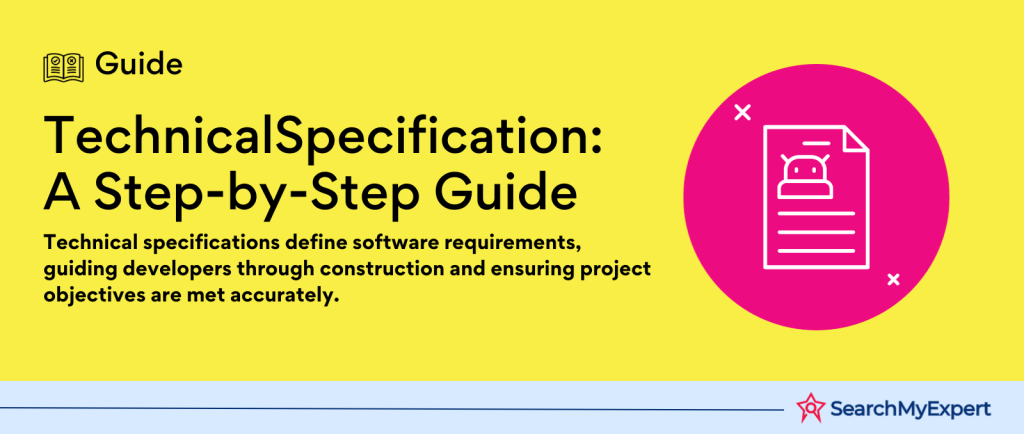What is a technical specification?
A technical specification is a document that describes the technical requirements for a software system. It provides a detailed and comprehensive description of the system’s functionality, performance, security, and other non-functional requirements. Technical specifications are used by software developers, testers, and other stakeholders to ensure that the system is developed and delivered in accordance with the agreed-upon requirements.
Why are technical specifications important?
Technical specifications are important for a number of reasons. First, they help to ensure that the software system meets the needs of its users and stakeholders. By clearly defining the system’s requirements, technical specifications help to reduce the risk of misunderstandings and errors. Second, technical specifications help to improve communication between the development team and other stakeholders. By providing a shared reference document, technical specifications help to ensure that everyone is on the same page. Third, technical specifications can help to reduce the cost of software development. By providing clear and concise requirements, technical specifications can help to avoid costly rework and delays.
Who uses technical specifications?
Technical specifications are used by a variety of stakeholders, including:
- Software developers: Developers use technical specifications to understand the system requirements and to design and implement the system.
- Testers:
Testers use technical specifications to develop test cases and to verify that the system meets the requirements. - Product managers: Product managers use technical specifications to communicate the system requirements to stakeholders and to track the progress of the development project.
- System architects: System architects use technical specifications to design the system architecture and to ensure that the system components meet the requirements.
- Other stakeholders: Other stakeholders, such as business users, customers, and regulators, may also use technical specifications to understand the system requirements and to ensure that the system meets their needs.
What are the benefits of using technical specifications?
There are a number of benefits to using technical specifications, including:
- Improved communication:
Technical specifications provide a shared reference document for all stakeholders, helping to improve communication and reduce misunderstandings. - Reduced risk:
Technical specifications help to reduce the risk of errors and omissions, by clearly defining the system requirements. - Reduced cost: Technical specifications can help to reduce the cost of software development by avoiding costly rework and delays.
- Increased quality:
Technical specifications help to ensure that the software system meets the needs of its users and stakeholders.
Types of technical specifications
Technical specifications can be classified into two main types: functional requirements and non-functional requirements.
Functional requirements describe the system’s features and functionality. They define what the system must do, but not how it must do it. Examples of functional requirements include:
- The system must be able to store and retrieve customer data.
- The system must be able to generate reports on sales performance.
- The system must be able to integrate with the company’s ERP system.
Non-functional requirements describe the system’s performance, security, usability, and other qualities. They define how the system must perform, but not what it must do. Examples of non-functional requirements include:
- The system must be able to handle 100 concurrent users.
- The system must be able to respond to requests within 2 seconds.
- The system must be secure against unauthorized access.
- The system must be easy to use for new users.
Technical specifications can also be classified by their scope. Some technical specifications are specific to a particular software feature or component. Others are more general and describe the requirements for the entire system.
Here are some examples of specific technical specifications:
- Technical specification for a new user registration feature
- Technical specification for a new search algorithm
- Technical specification for a new database schema
Here are some examples of general technical specifications:
- Technical specification for the system architecture
- Technical specification for the security requirements
- Technical specification for the performance requirements
How to write a technical specification
To write a technical specification, follow these steps:
- Gather requirements. The first step is to gather requirements from all stakeholders, including users, product managers, business analysts, and system architects. This can be done through interviews, workshops, and surveys.
- Prioritize requirements. Once all of the requirements have been gathered, they need to be prioritized. This will help to ensure that the most important requirements are implemented first.
- Document the requirements. The requirements should be documented in a clear and concise manner. The technical specification should include the following information for each requirement:
- Requirement ID: A unique identifier for the requirement.
- Requirement description: A clear and concise description of the requirement.
- Acceptance criteria: Criteria that must be met in order for the requirement to be considered satisfied.
- Priority:
The priority of the requirement. - Dependencies: Any other requirements that the requirement depends on.
4. Review and iterate on the requirements. The technical specification should be reviewed by all stakeholders to ensure that it is accurate and complete. Once the technical specification has been reviewed, the requirements may need to be iterated on.
Here are some tips for writing effective technical specifications:
- Be clear and concise. The technical specification should be written in a clear and concise manner that is easy for all stakeholders to understand.
- Be specific. The requirements should be specific and measurable. Avoid using vague or ambiguous language.
- Be complete. The technical specification should document all of the requirements for the system.
- Be consistent. The technical specification should use consistent terminology and formatting throughout.
- Be realistic. The requirements should be realistic and achievable.
Common mistakes to avoid when writing technical specifications
Here are some common mistakes to avoid when writing technical specifications:
- Not documenting all of the requirements. It is important to document all of the requirements for the system, even the ones that seem obvious. This will help to avoid misunderstandings and errors.
- Not prioritizing the requirements. Not all requirements are created equal. Some requirements are more important than others. It is important to prioritize the requirements so that the most important requirements are implemented first.
- Not writing the requirements in a clear and concise manner. The technical specification should be written in a clear and concise manner that is easy for all stakeholders to understand. Avoid using technical jargon and acronyms that your readers may not be familiar with.
- Not involving all stakeholders in the review process. It is important to involve all stakeholders in the review of the technical specification. This will help to ensure that the requirements are accurate and complete, and that they meet the needs of all stakeholders.
Here are some additional tips for avoiding common mistakes:
- Use a template. There are a number of templates available online that can help you to write a technical specification. Using a template can help you to ensure that your technical specification is complete and well-organized.
- Get feedback from others. Once you have written a draft of the technical specification, ask others to review it and provide feedback. This will help you to identify any errors or omissions.
- Keep it up to date. The technical specification should be kept up to date as the system requirements change. This will help to ensure that the technical specification is always accurate and complete.
By avoiding these common mistakes, you can write technical specifications that are clear, concise, and complete. This will help to ensure the success of your software development project.
Case studies
Here are two case studies of technical specifications in software development:
Case study 1: New user registration feature
A software company is developing a new user registration feature for its website. The technical specification for this feature would include the following requirements:
- The user must be able to enter their name, email address, and password.
- The user must be able to choose a username and profile picture.
- The user must be able to verify their email address.
- The user must be able to create a profile and manage their account settings.
The acceptance criteria for each of these requirements would be defined in detail. For example, the acceptance criteria for the requirement “The user must be able to enter their name, email address, and password” might be:
- The user must be able to enter their name in at least 3 characters and no more than 255 characters.
- The user must be able to enter their email address in a valid email format.
- The user must be able to enter a password that is at least 8 characters long and includes at least one uppercase letter, one lowercase letter, and one number.
Case study 2: Major software release
A software company is planning a major software release. The technical specification for this release would include the following requirements:
- The new software must be compatible with all of the company’s supported operating systems.
- The new software must be able to handle a higher volume of traffic.
- The new software must be more secure than the previous version.
- The new software must be easier to use for users.
The acceptance criteria for each of these requirements would be defined in detail. For example, the acceptance criteria for the requirement “The new software must be compatible with all of the company’s supported operating systems” might be:
- The new software must be able to run on Windows 10, macOS 12, and Linux Ubuntu 22.04.
- The new software must be able to run on all of the hardware platforms that are supported by the company’s current software.
These are just two examples of how technical specifications are used in software development. Technical specifications can be used to document the requirements for any type of software system, from a small feature to a major software release.
Conclusion
Technical specifications are an essential part of any software development project. By clearly defining the system requirements, technical specifications help to improve communication, reduce risk, and increase quality.
Here is a summary of the key points about technical specifications:
- Technical specifications describe the technical requirements for a software system.
- Technical specifications can be classified into two main types: functional requirements and non-functional requirements.
- Functional requirements describe the system’s features and functionality.
- Non-functional requirements describe the system’s performance, security, usability, and other qualities.
- To write a technical specification, gather requirements from stakeholders, prioritize the requirements, document the requirements, and review and iterate on the requirements.
- Here are some common mistakes to avoid when writing technical specifications:
- Not documenting all of the requirements.
- Not prioritizing the requirements.
- Not writing the requirements in a clear and concise manner.
- Not involving all stakeholders in the review process.
Here are some additional tips for writing effective technical specifications:
- Use a template.
- Get feedback from others.
- Keep it up to date.
Ignite your project with Software Development companies where exceptional is the standard!
Table of Contents
Toggle






